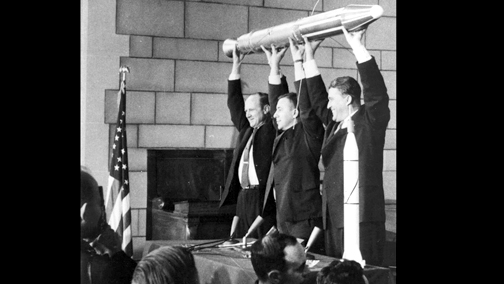
JPL Director William Pickering, scientist James Van Allen and rocket pioneer Wernher von Braun hold a model of Explorer I. Jan. 31 is the 60th anniversary of its launch.
By Charly SHELTON
This year’s calendar is populated with all kinds of astronomical events, from meteor showers to eclipses and more. But our local space center, Jet Propulsion Laboratory in La Cañada, has even more events to look out for in this year’s sky.
“JPL is incredibly busy. We have more work than ever, fabulous missions in science, in astrophysics and planetary science. It is a wonderful time to be at JPL and we could not be happier with how things are going,” said Dr. Dave Gallagher, associate director for Strategic Integration. “We got a new director about a year-and-a-half ago, Mike Watkins, who replaced Charles Elachi, who had been there for 15 years. So it is really a wonderful time to be at the lab.”
Gallagher has his finger on the pulse of JPL because he is in charge of overseeing all missions and technologies, and has had a hand in planning all of them.
“What [associate director for Strategic Integration] really means is I am responsible for what JPL is going to do, what kind of business we are pursuing,” Gallagher said. “I am responsible for our technology, our investments, and where we make our investments in advanced technology. I am responsible for formulation, coming up with mission ideas, and finally I’m responsible for the legislative affairs, which is government relationships with Capitol Hill, et cetera.”
Because there are so many upcoming missions and events in 2018 this will be the first of several updates during the year that CV Weekly will bring on what to look for in the skies of 2018, starting this month with a huge day.
On Jan. 31, there are several things happening. That night will see a full moon, a super moon (when the Moon is full at its closest approach to earth in its elliptical orbit), a blue moon (the second full moon in a month), and a lunar eclipse blood moon (when the earth passes between the sun and moon, blocking out all of the light for a short while and giving the moon a reddish hue before and after). It’s a super blue blood moon. In addition, it is the 60th anniversary of the veritable birth of JPL.
“After Sputnik in 1957, the U.S. was just completely freaking out because the Soviets were the first into space. You’ve got this thing flying a couple hundred miles overhead beeping and it is a symbol of Soviet space technology and dominance. What people don’t realize is the U.S. response to Sputnik came from Caltech.
“The first satellite was Explorer I. So this Jan. 31 will be the 60th anniversary of the launch of Explorer I. It was designed, built and operated by Caltech and what would become JPL,” Gallagher said. “Our most iconic photo [at JPL] is of William Pickering, who ended up being the first director of JPL, James Van Allen, who discovered the Van Allen radiation belt that was named after him, and Wernher Von Braun. [The three] are standing at the National Academy of Science holding Explorer I over their heads. It is an amazing picture. And that is the birth of JPL, and how we got started. We are very excited about that.”
Moving further into the year there are missions that will look to explore space, but also those meant to look back at our home planet, to better understand our world’s behavior and our relationship to it.
“In spring 2018, there is something called GRACE Follow-On, or GFO, that will launch as an Earth Science mission. GRACE stands for Gravity Recovery And Climate Experiment, so it is a follow-on to the first GRACE and it is going to continue that work,” Gallagher said.
GRACE operated for 15 years and eventually died long past its expected lifetime. It consisted of two spacecraft that made highly accurate measurements of the variation of Earth’s gravity. This provided all types of information about what was going on under the Earth’s surface in drought areas or big areas of subsidence that opened up. GRACE tracks changes caused by additional water in the ocean, because this all affects gravity.
“It’s something that has a lot of practical benefits to society,” said Gallagher. “There is also a smaller instrument that is going to be launched called Eco Stress in June 2018. That’s also an Earth Science mission.”
Other astronomical events of note for the winter and spring will include a partial solar eclipse on Feb. 15 and the Lyrid meteor shower on April 22 and April 23.
More information on GRACE and Eco Stress can be found at JPL.NASA.gov, along with other upcoming missions.
In the spring, CV Weekly will continue this article series on what to look for in the summer.
